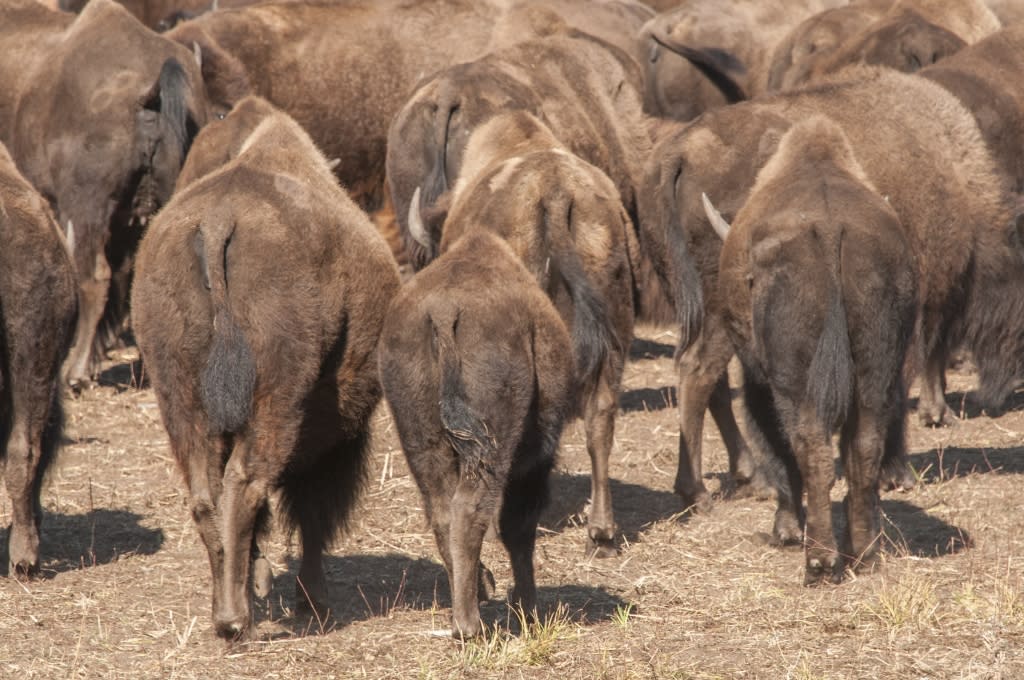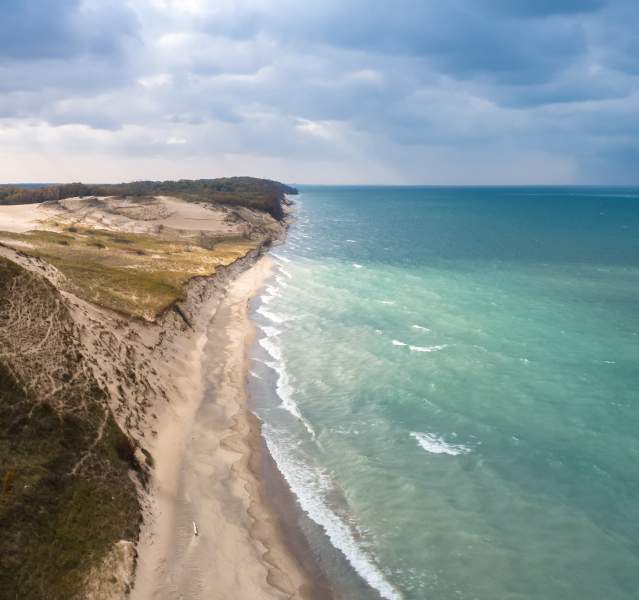Ten more bison have just arrived at Kankakee Sands! On the morning of the release, the doors of the trailer swung wide open and the new arrivals bounded out. The Kankakee Sands herd was there ready and waiting to greet them. The two groups sniffed noses, trotted around in excitement and then off they ran as one.
 2014 TNC bison roundup (west herd).
2014 TNC bison roundup (west herd).
We brought this new group of seven cows and three bulls from Wind Cave National Park in South Dakota to Kankakee Sands in order to bring new genetic material to our own herd. Over the next couple years all of our animals will be part of an exciting, multi-agency study of bison genetics. Bison genetics have been studied for many years, and this more detailed research will help the scientific community “get to the bottom” of the bison’s genetic story. Literally.
The Nature Conservancy owns and manages thirteen bison herds in North America. Of these thirteen, six have been established with bison originating from Wind Cave National Park. Our very own Kankakee Sands herd that arrived last year was also established with Wind Cave genetics. The six Conservancy sites will be participating in a genetic study with Wind Cave National Park that will use a powerful genetics test to search for cattle genes within the bison herds.
At one time, the great herds of 50-60 million bison reached from the wilds of Canada to the warmth of Mexico. As bison were hunted, the population of bison dwindled to less than 1000 animals by the year 1889. In order to preserve the species and to make bison economically successful, many bison were bred with cows with the hope of making a cattle-bison cross that would be more resistant to disease, require less feed, and produce more calves. This cross-breeding failed; the resulting crosses did not exhibit the hybrid vigor that was hoped for.
This crossing of genetic material, at a time when so few bison were left, risked diluting the wildness that makes the bison such an amazing species. There is nothing like a bison to invigorate a prairie landscape. Their ability to increase prairie vigor by eating grasses and sedges, thus increasing floral diversity is the precise reason bison were brought to Kankakee Sands.
The good news is that, using the current method for genetic testing, Wind Cave’s bison herd has been found to be free from cattle gene introgression. It’s an interesting and fortuitous story. In the early 1900’s, the Bronx Zoo had taken some of the last remaining bison in the wild and brought them into captivity for the protection and preservation of the species. The American Bison Society was created in 1913 with the hope of establishing wild bison herds on large acres. With the help of the American Bison Society, bison were taken from the Bronx Zoo and moved to Wind Cave National Game Reserve, which would eventually become Wind Cave National Park. What luck that the bison which were originally taken to the zoo were cattle-gene free!
As we embark on this new and exciting study of bison genetics, we must first look not at the majestic head of the bison, but rather the other end of the beast. Oddly, it all begins with a tail hair. During the bison’s annual wellness check and vaccine administration, several hairs from each bison’s tail are removed for the purpose of genetic testing. The tail hairs will give us the knowledge we need to help us manage our herd at Kankakee Sands to be as genetically diverse and as strong as possible.
The tail hairs certainly won’t be the “end” of the genetic study of bison, but they will provide insight into the relationships of bison with one another. We will continue to study not only these intra-species relationships, but also the relationship of bison to the prairie. The bison’s tale is just beginning to unfold at Kankakee Sands. We hope that you will visit again and again to experience the story yourself.

The Nature Conservancy’s Kankakee Sands is an 8,300-acre prairie and savanna habitat in Northwest Indiana, open every day of the year for public enjoyment. For more information about Kankakee Sands, visit www.nature.org/KankakeeSands.

